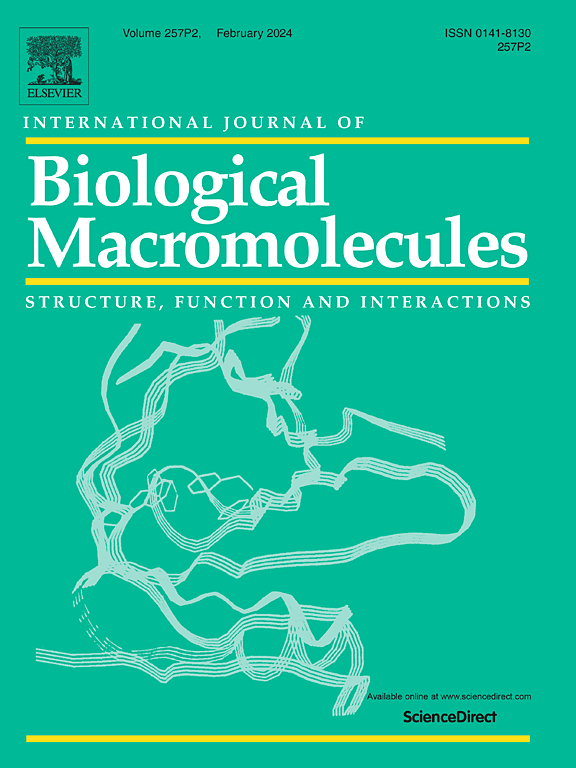Molecular insights into the unique activation and allosteric modulation mechanisms of the human mas-related G-protein-coupled receptor X1
IF 8.5
1区 化学
Q1 BIOCHEMISTRY & MOLECULAR BIOLOGY
International Journal of Biological Macromolecules
Pub Date : 2025-06-01
DOI:10.1016/j.ijbiomac.2025.144815
引用次数: 0
Abstract
MRGPRX1 plays dual roles in mediating nociception and pruritus, making it a promising target for alleviating itch and inhibiting pain. However, the mechanisms underlying MRGPRX1 activation and allosteric modulation remain poorly understood, posing significant challenges for structure-based drug discovery. Here, we employ Gaussian accelerated molecular dynamics (GaMD) for enhanced sampling of MRGPRX1, successfully obtaining a stable inactive conformation of the unbound receptor for the first time. Through comparative analyses with the previously resolved active conformation, we reveal how the subtle structural and dynamic changes of MRGPRX1 transition it from the inactive to the active state in the absence of the W6.48 toggle switch and other conserved motifs, providing insights into agonist-induced receptor activation. Furthermore, we integrate neural relational inference (NRI) deep learning with binding free energy calculations to elucidate the molecular basis of ML382's positive allosteric modulation (PAM) activity. Most strikingly, ML382 enhances the overall binding affinity of the peptide agonist BAM8–22 for MRGPRX1 via short-range interactions, while also modulates the conformations of the distal G-protein-binding site towards the fully active state through long-range pathways. Taken together, our study advances the molecular understanding of MRGPRX1 activation and allosteric modulation, thereby accelerating the rational design of analgesic and antipruritic drugs.
人类质量相关g蛋白偶联受体X1的独特激活和变构调节机制的分子见解
MRGPRX1具有介导痛觉和瘙痒的双重作用,是缓解瘙痒和抑制疼痛的理想靶点。然而,MRGPRX1激活和变构调节的机制仍然知之甚少,这给基于结构的药物发现带来了重大挑战。在这里,我们采用高斯加速分子动力学(GaMD)对MRGPRX1进行增强采样,首次成功获得了未结合受体的稳定非活性构象。通过与先前确定的活性构象的比较分析,我们揭示了MRGPRX1在缺乏W6.48开关和其他保守基序的情况下,如何通过微妙的结构和动态变化将其从非活性状态转变为活性状态,为激动剂诱导的受体激活提供了新的见解。此外,我们将神经关系推理(NRI)深度学习与结合自由能计算相结合,以阐明ML382的正变构调节(PAM)活性的分子基础。最引人注目的是,ML382通过短程相互作用增强了肽激动剂BAM8-22对MRGPRX1的整体结合亲和力,同时也通过远程途径调节远端g蛋白结合位点的构象,使其达到完全活性状态。综上所述,我们的研究促进了对MRGPRX1激活和变构调节的分子理解,从而加速了镇痛和止痒药物的合理设计。
本文章由计算机程序翻译,如有差异,请以英文原文为准。
求助全文
约1分钟内获得全文
求助全文
来源期刊
CiteScore
13.70
自引率
9.80%
发文量
2728
审稿时长
64 days
期刊介绍:
The International Journal of Biological Macromolecules is a well-established international journal dedicated to research on the chemical and biological aspects of natural macromolecules. Focusing on proteins, macromolecular carbohydrates, glycoproteins, proteoglycans, lignins, biological poly-acids, and nucleic acids, the journal presents the latest findings in molecular structure, properties, biological activities, interactions, modifications, and functional properties. Papers must offer new and novel insights, encompassing related model systems, structural conformational studies, theoretical developments, and analytical techniques. Each paper is required to primarily focus on at least one named biological macromolecule, reflected in the title, abstract, and text.

 求助内容:
求助内容: 应助结果提醒方式:
应助结果提醒方式:


